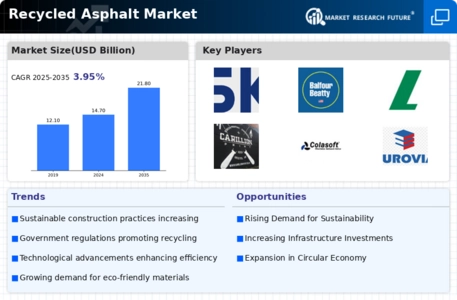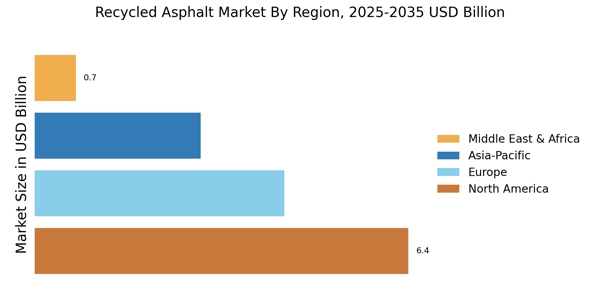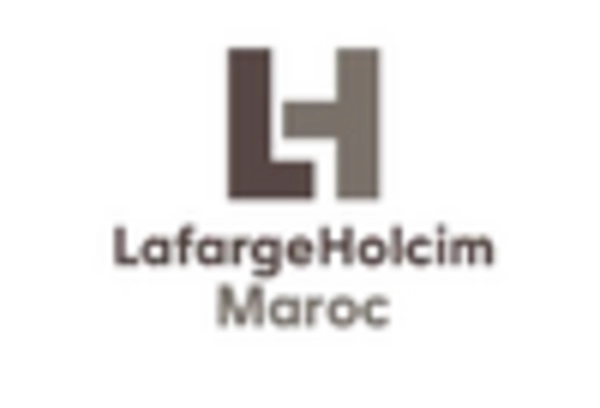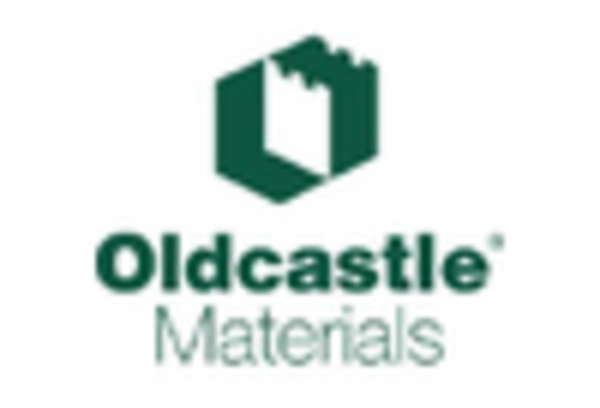Regulatory Support for Recycling
The Recycled Asphalt Market benefits from increasing regulatory support aimed at promoting sustainable practices. Governments are implementing policies that encourage the use of recycled materials in construction and road maintenance. For instance, regulations may mandate a certain percentage of recycled asphalt in new road projects, thereby driving demand. This regulatory framework not only supports environmental goals but also stimulates economic activity within the Recycled Asphalt Market. As a result, companies are likely to invest in recycling technologies and processes to comply with these regulations, potentially leading to a more robust market. Furthermore, the alignment of these regulations with broader sustainability initiatives enhances the attractiveness of recycled asphalt as a viable alternative to traditional materials.
Infrastructure Development Initiatives
The Recycled Asphalt Market is significantly influenced by ongoing infrastructure development initiatives across various regions. Governments are investing heavily in upgrading and maintaining transportation networks, which often includes the use of recycled materials. For instance, many infrastructure projects now incorporate recycled asphalt to enhance durability while reducing environmental impact. This trend is particularly evident in road construction and maintenance, where recycled asphalt is increasingly viewed as a standard material. The emphasis on sustainable infrastructure development not only supports the Recycled Asphalt Market but also aligns with broader economic goals of job creation and resource efficiency. As these initiatives continue to unfold, the demand for recycled asphalt is expected to rise, further solidifying its role in modern construction practices.
Cost-Effectiveness of Recycled Materials
The Recycled Asphalt Market is experiencing a surge in demand due to the cost-effectiveness of using recycled materials. The production of recycled asphalt is generally less expensive than that of new asphalt, which can lead to significant savings for construction projects. According to recent data, the use of recycled asphalt can reduce material costs by up to 30%, making it an appealing option for budget-conscious projects. This financial incentive is particularly relevant in an era where construction budgets are often tight. As more contractors recognize the economic advantages of incorporating recycled asphalt into their projects, the market is likely to expand. This trend not only supports the growth of the Recycled Asphalt Market but also encourages sustainable practices in the construction sector.
Growing Demand for Sustainable Construction
The Recycled Asphalt Market is poised for growth as the demand for sustainable construction practices continues to rise. Stakeholders, including consumers and businesses, are increasingly prioritizing environmentally friendly materials in their projects. This shift is driven by a growing awareness of climate change and the need for sustainable development. The construction sector, which is a significant contributor to carbon emissions, is under pressure to adopt greener alternatives. Recycled asphalt, being a sustainable option, aligns well with these evolving preferences. As a result, the market for recycled asphalt is likely to expand, with more construction firms seeking to incorporate these materials into their projects. This trend not only enhances the reputation of companies but also contributes to the overall sustainability goals of the industry.
Technological Innovations in Recycling Processes
The Recycled Asphalt Market is benefiting from technological innovations that enhance the efficiency and effectiveness of recycling processes. Advances in machinery and techniques allow for higher quality recycled asphalt, which meets the stringent standards required for modern construction. For example, new technologies enable the extraction of asphalt from old pavements with minimal contamination, resulting in a superior product. This improvement in quality is crucial as it directly impacts the performance and longevity of the recycled asphalt in various applications. As these technologies continue to evolve, they are likely to attract more players into the Recycled Asphalt Market, fostering competition and further driving innovation. Consequently, the market may witness an increase in the adoption of recycled asphalt in both public and private sector projects.


















Leave a Comment